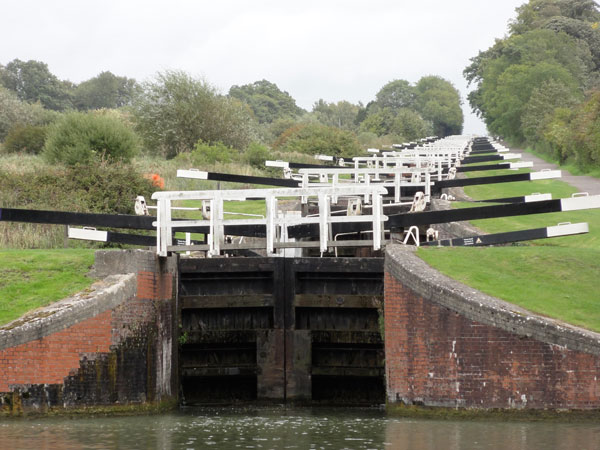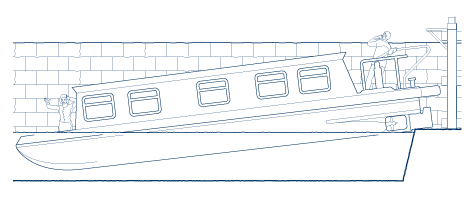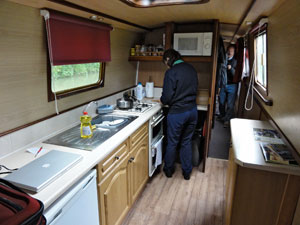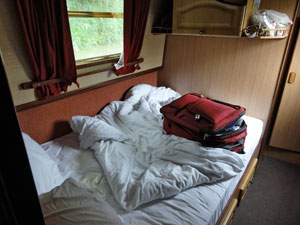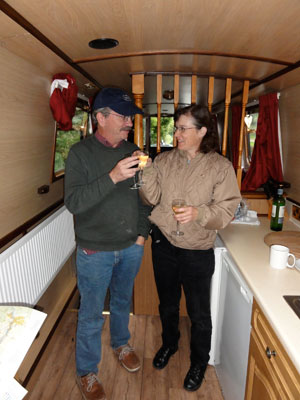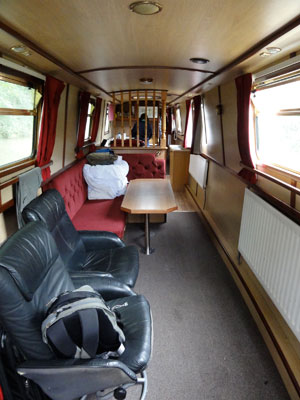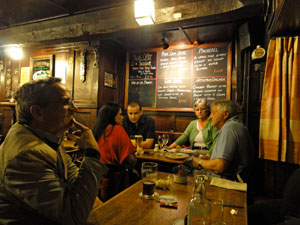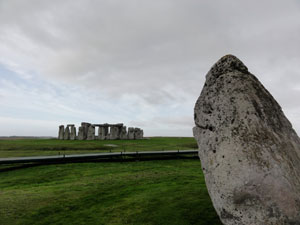Four Yanks in a Boat: From Bath to Devizes and back
The Kennet and Avon Canal is over two hundred years old, which might make it seem an unlikely choice for a 21st-century vacation, but the combined age of myself, my husband Jim, our friend Lee and her brother Jim is well over that, so perhaps it was appropriate.
Of course, the canal was completely restored by the Kennet & Avon Canal Trust in the 1980s, but the original canal was completed in 1810. Through the Avon Navigation (in other words the Avon River), it connects Bristol to Bath, and through the K&A Canal connects Bath and Reading, and the Kennet Navigation (the Kennet River) connects Reading to the Thames, and it was pretty high tech in its day.
Our time on the canal started in Bath at Sydney Wharf. The canal connects with the Avon River in Bath just a short distance from the wharf, although five locks separate it from the Avon. By traveling east from Bath, however, we didn’t encounter our first lock until Bradford on Avon.
Lots of locks
Now locks are a curious steampunky sort of thing, although of course the first canals predate the steam age and it was the steam locomotive that ended the very short reign of the canals. I suppose they’re really hydropunk because it’s just water pressure that operates a lock. A lock really can only work because water flows downhill, but by emptying then filling or filling then emptying you can move a narrowboat uphill or downhill, but in all cases you’re losing water so there needs to be several reservoirs along the path of the canal.
The Claverton pumping station used a wheel turned by the Avon (the canal and the rive run side by side) to lift water to reservoirs. Several springs along the way also fed reservoirs. The Crofton pumping station did use steam engines to lift water and both pumping stations still operate for visitors on selected days but now electrically driven pumps maintain the reservoirs.
A bit of nomenclature: the gates are swung open by their balance beams. Paddles are opened below the top gate (the uphill gate) or in the bottom gate via rack and pinion gears operated by a windlass key.
Paddles below the top gate admit water from the uphill side into the lock and paddles in the bottom gates let water out. So to go up uphill, you enter through the bottom gates after releasing whatever water is in the lock chamber through the gate paddles. The lock is often full or partially full unless a boat has just exited downhill because water leaks through the not very watertight top gates. Then you slowly enter the lock and close the gates behind you. And you’ve got to make sure the gate paddles are closed. The last person to have navigated the locks is supposed to have closed all the gates and all the paddle, but once we found to our chagrin that we were trying to flood a lock in which a paddle was left open, wasting a great deal of water. After that, I always remembered to check that the bottom paddles were closed before opening the top paddle.
After the boat is inside and the bottom gates and paddles are closed, the top gate is opened. Once the water level in the lock equalizes with the uphill side of the canal, you can open the gates and proceed on your way, remembering to close the gates and paddles after the boat has exited.
“Turning a lock”
Our first experiences at “turning a lock” was not bad because there were usually experienced narrowboaters who offered advice, but there are eight locks between Bath and Foxhangers Wharf just west of Devizes, which meant that we eventually did have to operate a lock alone. With four of us on board, it wasn’t too difficult but there was a fair bit of physical comedy. The helmsman would need to pull up alongside the tow path (boats were originally pulled by horses or people along the tow path), usually at a landing with a wooden rail and convenient bollards. Oftentimes we just rammed into the landing. Someone would loop a bollard with the bow line while two people would jump off and proceed to the lock. If we were going uphill, they would empty the lock, open the gates, close the gates, fill the lock, open the gates and then close the gates. The paddles were opened by rack and pinion gear turned by a windlass key (an L-shaped metal bar). The paddles were prevented from dropping by a ratchet and pawl that needed to be lifted out of the way when lowering the sluice. They looked like devices created for the sole purpose of losing fingers. And you needed to remember to keep your hand on the windlass key while lowering or else it would spin madly and fly off in the direction of your face.
There were other dangers to avoid, like not tying your boat to the bollards along the lock chamber, or else you’d dangle the boat while releasing water. And you needed to avoid the cill, a concrete shelf on the uphill side under which water was admitted into the lock chamber, when lowering the water, else you might find the stern of the boat hung up on the cill while the bow dipped down. I love this illustration because the helmsman looks like he’s on his cellphone.
We all avoided the cill (everyone of the crew steered the boat through a lock at least once), but we all managed to crash into the bottom gates opposite the cill. There is also a danger of catching the prow of the boat in a gate while raising the water level and some danger of opening the uphill sluices too fast, swamping the boat. Miraculously we avoided any major injuries or serious damage to the locks, but we all experienced recalcitrant rack and pinion gears. Sometimes raising a gate required a great effort, leaving me sweating despite the rain we enjoyed on the outbound trip. And some of us didn’t have the required bulk to get the gate beams or the swing bridges to move easily.
After navigating the locks, the lock operators would need to be picked up on the other side of the lock, but at the flight of five locks in Seend it was easiest for the lock operators to simply walk to the next lock. After all, we could walk much faster than the boat. It was easy to see that three people could easily operate a lock, one person at the tiller, one person in the bow to handle the line and push off once the gates were opened and one person to open the gates. With the use of a center line long enough to reach the stern, the helmsman could easily tie up the boat, requiring only one person to operate the lock. However without a current, it would be easy on a still day to keep the boat at the landing without tying up. We did encounter a boat with a crew of one.
Unfortunately some of the complaints we’d read about poor maintenance along the K&A proved correct. We encountered several locks with broken paddle gearing, making the process of filling the lock very slow.
Steering
Navigating a 65-foot boat that is designed to accommodate four to six people is quite daunting, especially around obstacles such as the Dundas Aqueduct, which carries the canal over the Avon River. And inevitably you’ll need to turn the boat around, which we accomplished at Foxhangers Wharf. There are several places along the canal to turn a boat around. They’re called winding holes (pronounced like the meteorological term) and are marked for the maximum length of boat you can turn around.
Unfortunately steering a narrowboat is not an easy thing. For one thing you’ve got a tiller, so to move the bow of the left you push the tiller to the right. But if you’re trying to move the stern of the boat, you do push the tiller in the direction you want. Add to this complication that the boat needs to be moving in order to steer it. And it’s almost impossible to steer in reverse. So to turn a boat around in a winding hole, your procedure is thus: you need to coast into the winding hole and apply enough reverse thrust to slow the boat, then push the tiller hard port or starboard while applying a lot of throttle. The boat always turns about the mid point so you need to do a 180-degree turn. But with a boat as long as ours, we were told the best way to turn was to run the bow aground and swing around the prow. Which was accomplished by Jim Thomas, Lee’s brother, in Foxhanger’s Wharf during a very strong wind that caught our long, long boat and ruined his plans for an elegant turnaround.
Other challenges were encountering boats heading in the opposite directions at a bridge; the quick turns required to drop a crew member to move a swing bridge and immediately pick them up on the other side; and the sharp turns on either side of the Dundas aqueduct. And finally when we returned the boat, we were told we needed to turn the boat around and back into our berth. Despite Jim Thomas’ best efforts, we needed to take on a pilot who backed us into place.
We encountered little wildlife other than ducks, herons and the feral boat people who live on the canals at private moorings. You have to be a little quirky to live on a 7-foot wide boat, with your roof garden, solar cells and wind generators while tourists speed by at 3 mph, rocking your home in their wake.
A narrowboat is actually quite luxurious, if you’re short and skinny. (Hotel boats are even more luxurious.) There are beds or bunks, toilets, showers, full kitchen and TV and stereo. All the electrical appliances run off the 12V battery that is charged by the diesel energy. Water is heated by the engine, which actually remains hot long after the engine is turned off. There’s supposedly a propane water heater that we could never get to light. We were concerned about how much water we consumed and how much waste we produced, although we later learned that shower and sink water was dumped into the canal. We never needed to dump the waste tanks.
We picked up the boat about 3 p.m. Monday and were underway about 4:30 p.m. after a brief orientation by Paddy. We returned it about 9 a.m. Friday. We spent the first night near Limpley Stoke and had dinner at the Hop Pole Inn. Tuesday night we arrived near Foxhangers Wharf and ate dinner at the Three Magpies where we found that we could take a taxi to Stonehenge the next day, rather than take a bus to Salisbury and then another bus from Salisbury to Stonehenge.
The next day taxi driver Herbert “Jim” Elmes took us to Stonehenge. Unfortunately the trip was so speedy — they do drive fast through those narrow country lanes — that we arrived before Stonehenge opened. Rather than wait, we pressed our noses to the chain link fence and took our photos and Jim returned us to Devizes, where we wandered through the quaint medieval city and found a rather nice bookshop, Devizes Book on Sidmouth, not far from the Market Cross and the Wadworth Brewery, makers of The Bishops Tipple, Farmers Glory and 6X among others. We also visited the K&A Canal Museum, operated by the trust. But the highlight of day was walking back down Caen Hill and the flight of 16 locks we avoided by turning around at Foxhangers. Those locks are a proud monument to Georgian engineering and the power of tourism, because by the 1950s commercial traffic had all but died on Britain’s canals, and yet by the 1990s they were they contributing to the local economies of many small towns by catering to tourist travel.
I’d highly recommend narrowboating. If you want more information, visit the British Waterways website. We rented our boat from AngloWelsh Water Holidays, who were great, and you can also find lots of other boat hires through the Waterways website.

